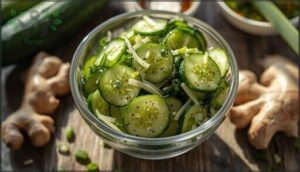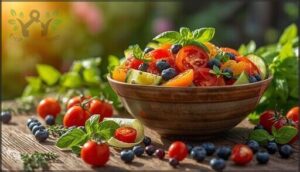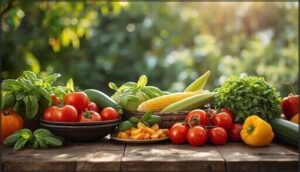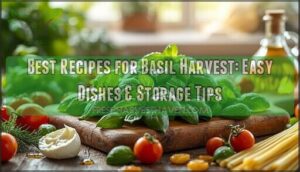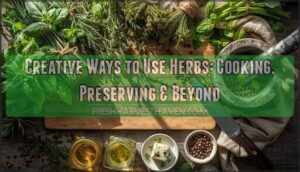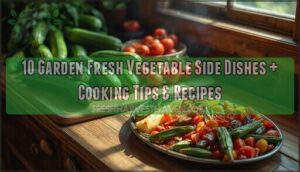This site is supported by our readers. We may earn a commission, at no cost to you, if you purchase through links.
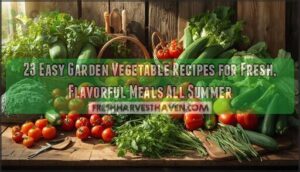 Your garden is bursting with zucchini the size of baseball bats, tomatoes piling up faster than you can eat them, and enough leafy greens to open a salad bar. You planted with good intentions, but now you’re staring down a vegetable avalanche with no clue what to cook.
Your garden is bursting with zucchini the size of baseball bats, tomatoes piling up faster than you can eat them, and enough leafy greens to open a salad bar. You planted with good intentions, but now you’re staring down a vegetable avalanche with no clue what to cook.
The same steamed broccoli or sad side salad won’t cut it anymore. You need recipes that actually excite you—dishes that let those fresh flavors shine without requiring culinary school skills or a pantry full of exotic ingredients.
These easy garden vegetable recipes turn your harvest into meals you’ll crave, not chore through, with simple techniques that work whether you picked the produce this morning or grabbed it from the farmers market on your lunch break.
Table Of Contents
- Key Takeaways
- Easy Garden Vegetable Recipes for Every Meal
- Quick and Healthy Summer Salads
- Simple Pasta, Stir-Fry, and Wrap Ideas
- Fresh Summer Vegetable Recipe Inspiration
- Top 6 Essential Ingredients for Garden Recipes
- Frequently Asked Questions (FAQs)
- What are some summer vegetable recipes?
- How do I use up vegetables from my garden?
- Are there no-cook recipes for vegetables?
- What is the best way to cook summer vegetables?
- What vegetables are no-Cook?
- How long does it take to prepare a summer vegetable dish?
- What’s the easiest vegetable to grow in a garden?
- What to make with fresh garden vegetables?
- How to can garden vegetables for beginners?
- What vegetables pair well in a garden?
- Conclusion
Key Takeaways
- Garden-fresh recipes like grilled pizza, stuffed peppers, and lemony zucchini ribbons make it easy to turn a vegetable surplus into crave-worthy meals.
- Simplicity rules: use familiar ingredients, straightforward techniques, and quick swaps to spotlight the natural flavors of your harvest without fuss.
- Creative salads, pastas, and wraps help you use up vegetables fast while keeping meals exciting and nutritious all summer long.
- Stocking up on core ingredients—like sea salt, garlic, and vinegar—lets you boost garden produce with bold, balanced flavor every time.
Easy Garden Vegetable Recipes for Every Meal
Some meals just taste like summer, don’t they? Grab your favorite garden vegetables and get ready for recipes really worth sharing.
Here are a few you can count on for flavor, ease, and plenty of fresh ingredients.
Smoky Grilled Pizza With Greens & Tomatoes
Flip the switch on ordinary pizza night with this Grilled Pizza loaded with greens and tomatoes. Let the dough pick up those signature smoky flavors—think Grill Master Tips in action.
Pile on garden fresh veggies and favorite pizza toppings for a taste of summer recipes at their best. Pair with a summer salad for a vibrant, veggie-packed meal.
The key to a great grilled pizza is using the right smoky grilled techniques to bring out the flavors.
Stuffed Poblano Peppers With Garden Veggies
Prefer your veggies with a bold kick? Try stuffing poblano peppers with garden-fresh vegetables and savory grains. These Grilled Stuffed Peppers deliver big flavor and eye-catching color, with plenty of protein and fiber to keep you feeling full. Whether you follow the latest food trends or just want a tasty twist, this veggie nutrition star is always a crowd-pleaser.
Stuff your poblano peppers with garden vegetables and grains for a bold, colorful dish bursting with protein, fiber, and flavor
- High protein, fiber, and vitamin C
- Endless healthy eating swaps: black beans, chicken, or quinoa
- Poblano Recipes with Garden Vegetable goodness
- Great for meal prep or stress-free entertaining. This recipe is a great example of a healthy meal option.
Crunchy Lemon-Pesto Garden Salad
If your garden vegetables are calling, answer back with this Crunchy Lemon-Pesto Garden Salad. The zucchini ribbon prep makes every forkful feel sunny, while the pesto flavor profile brightens classic summer salads.
Loaded with protein, fiber, and vitamins, you can swap out bacon for seeds or chickpeas—it’s all about fresh, healthy recipes that celebrate seasonal ingredient swaps.
Chicken Soup With Dill and Spinach
After the bright pop of a lemon-pesto salad, sometimes you crave that bowl-you-could-hug comfort.
Enter chicken soup with dill and spinach—one of those garden vegetable recipes that bring real immune benefits and a nutrient analysis you can trust.
Feel free to swap in dill substitutes or toss in extra greens. It’s soup season, every season.
Cajun Sirloin With Mushroom Leek Sauce
Let Cajun spice wake up your weeknight with bold flavor. Imagine this: a sizzling sirloin crusted in seasoning, topped with a sauce reduction of sautéed mushroom varieties and leeks—rich, earthy, and silky. You’ll master key vegetable cooking techniques as you:
- Select beef cuts.
- Prep leeks.
- Sauté mushrooms.
- Reduce your garden vegetable sauce.
Lemony Zucchini Ribbons
Fresh ribbons of zucchini don’t just look pretty—they soak up every drop of citrus and olive oil, making them a perfect star for healthy summer recipes. Whether you’re chasing food trends or just want extra crunch, this dish is all about easy, garden-fresh flavor.
Zucchini nutrition means fiber, vitamins, and less guilt on your plate. It’s truly summer in every bite.
Quick and Healthy Summer Salads
When the weather heats up, there’s nothing like a crisp, invigorating salad. Garden veggies shine brightest when you keep things simple and quick.
Here are a few summer favorites you can toss together in a flash.
Cucumber-Ginger Salad
Ever think a salad could actually beat the summer heat? The Cucumber-Ginger Salad does just that, thanks to its hydrating Cucumber Nutrition and zesty Ginger Benefits.
It’s crunchy, cool, and surprisingly bold for such simple ingredients—think: scallions, sesame oil, and a tangy twist of Salad Dressings.
Perfect for Healthy Snacking or pairing with other Summer Vegetable Recipes.
Summertime Tomato Salad With Blueberries
Summer Salads get a sweet twist with this Summertime Tomato Salad With Blueberries. Juicy tomatoes mingle with plump blueberries, packing Tomato Nutrition and Blueberry Benefits into every bite.
It’s a fresh produce celebration—garden recipes like this make the most of summer vegetable recipes and let you taste just how bright and crisp vegetable recipes with summer produce and fresh vegetables can be.
Ramen Noodle Garden Salad
Craving something crisp, colorful, and cool? Ramen Noodle Garden Salad is the crowd-pleaser you’ll want on repeat.
Thanks to quick Preparation Time Savings and countless Noodle Salad Variations—think Seasonal Vegetable Additions or subtle twists in Dressing Flavor Profiles—it’s easy to tweak for Dietary Modifications.
Celebrate your Garden Bounty and get more mileage from fresh vegetables with this smart staple.
Broccoli With Asiago Cheese
You’ll love how simple broccoli becomes special when paired with nutty Asiago cheese. Roasting broccoli tips the florets crispy at the edges—just toss them with olive oil and roast for 15 minutes before sprinkling on shredded cheese.
The nutritional benefits shine through with vitamins C and K, plus calcium from the cheese.
Recipe variations are endless: try different flavor combinations with garlic or red pepper flakes for vegetarian recipes that celebrate your garden vegetable bounty.
Lemon-Parmesan Broiled Asparagus
Bright lemon and salty Parmesan wake up fresh asparagus in just 10 to 15 minutes under the broiler. Broiling temperatures around 400°F deliver tender spears with crispy edges—perfect as a vegetarian side dish alongside grilled chicken or steak.
Try these flavor pairings to improve your asparagus recipes:
- Garlic and red pepper flakes for heat
- Vegan options using plant-based Parmesan
- Panko breadcrumbs for added crunch
- Extra lemon zest for brightness
Different asparagus varieties all work beautifully in summer vegetable recipes.
Simple Pasta, Stir-Fry, and Wrap Ideas
When your garden’s overflowing with vegetables, pasta and wraps become your best friends. These dishes come together fast and let you toss in whatever you’ve got growing.
Here are five easy ways to turn fresh produce into filling weeknight meals.
Garden Vegetable Gnocchi
Through the lens of garden to table cooking, Garden Vegetable Gnocchi brings together Gnocchi Variations and Roasting Vegetables for rich flavor combinations. Homemade Recipes using seasonal ingredients offer big Nutritional Benefits—think vitamin-packed, fiber-rich, and hearty.
Recipe Trends favor these Summer Vegetable Recipes because they’re quick, endlessly customizable, and celebrate what’s fresh. You’ll find vegetable recipes like this become weeknight staples.
Italian-Style Veggie Wraps
When you need a quick summer cooking idea, Italian-style veggie wraps are your friend. Wrap nutrition shines here—grilled zucchini, peppers, and tomatoes nestle in soft tortillas with pesto variations or lighter dressings.
With consumer trends leaning into gluten-free options and fresh vegetable recipes, these wraps offer endless homemade twists and satisfy on-the-go cravings, all without skimping on flavor.
Pepper Ricotta Primavera Skillet
Let’s roll from garden wraps to a skillet classic—a Pepper Ricotta Primavera that’s quick enough for weeknights, and chock-full of recipe inspiration.
It’s light, creamy, and loaded with garden peppers for a Mediterranean diet fit. Ricotta health benefits join with easy primavera recipe variations, making this a summer cooking idea you’ll come back to through every vegetable season.
Ginger Veggie Brown Rice Pasta
From garden to table in 30 minutes, this Ginger Veggie Brown Rice Pasta puts a gluten-free twist on classic stir-fry—think deconstructed egg roll with a kick. It’s packed with 21 grams of protein per serving, crisp Brussels sprouts, cabbage, and red pepper, all tossed with ginger’s anti-inflammatory punch.
- Brown rice pasta cooks to al dente in 15 minutes for easy digestion
- Vegetables sauté in coconut oil with garlic and ginger paste until crisp-tender
- Rotisserie chicken adds quick protein, or swap in tofu for plant-based meals
- Recipe adaptations let you customize veggies based on what’s thriving in your garden
Whole Grain Garden Chow Mein
This whole grain chow mein swaps refined noodles for whole wheat spaghetti, boosting fiber to 4 grams per serving while keeping things under 310 calories. Toss broccoli, bok choy, and carrots with teriyaki meatballs for 18 grams of protein.
The whole grain benefits include better digestion and reduced inflammation. You can mix up chow mein variations using whatever vegetables your garden’s producing right now.
Fresh Summer Vegetable Recipe Inspiration
Summer’s peak brings an avalanche of corn, tomatoes, and ripe garden vegetables that deserve creative treatment.
These recipes celebrate what’s growing right now with bold flavors and easy techniques. From Mexican-inspired street corn to invigorating Spanish gazpacho, you’ll find fresh ways to use your harvest.
Mexican Street Corn Salad
You’ll love this Mexican food classic that’s become a go-to for summer recipes. Mexican Street Corn Salad brings grilled recipes and corn nutrition together in one bowl.
With 225 calories per serving and 35% of your vitamin C, it’s among the best vegetable recipes you can make. Try different salad variations using flavor enhancers like lime, cotija, and chili powder.
These corn recipes capture real summer vegetable recipes magic.
Creamy Corn Pasta
Blending fresh corn into a silky sauce transforms ordinary pasta recipes into something special. This dish captures garden harvest magic while packing 474 calories and 15 grams of protein per serving.
Master these cooking techniques for your summer vegetable recipes:
- Blend half the corn kernels to create natural creaminess without heavy cream
- Reserve pasta water to adjust sauce consistency perfectly
- Stir in Parmesan off-heat so it melts smoothly without breaking
- Add fresh basil last to preserve its bright flavor and color
Sweet Corn Pizza
Sweet corn on pizza might sound unusual in the U.S., but it’s a superstar topping in the UK and Asia, with over 6.6 million requests annually.
This culinary innovation brings crunch, natural sweetness, and extra fiber to your summer vegetable recipes. Try roasting or grilling corn first for smoky notes, then pair it with peppers and zucchini for a colorful, nutrient-rich grilled pizza.
Corn Fritters
Corn fritters bring Southern comfort food straight to your summer vegetable recipes lineup. These golden bites cook in under 30 minutes and deliver 4.8 grams of fiber per cup serving—making them smart farmers market recipes for busy weeknights.
- Frying techniques: Keep oil at 325°F for even browning
- Fritter variations: Add jalapeños or fresh herbs
- Dietary adaptations: Pan-fry instead of deep-frying to cut fat
- Storage options: Refrigerate up to 2 days and reheat in a skillet
Classic Panzanella Salad
This Tuscan origins classic turns day-old bread into something special. Combine sourdough cubes with ripe heirloom tomato varieties, fresh basil, and a simple dressing of olive oil and red wine vinegar.
Let it rest for 30 minutes so the bread soaks up all those juices. You’ll get 4 grams of fiber and 30% of your daily vitamin C in one serving suggestion.
Easy Gazpacho
When heat waves hit, you need something even cooler than salad. Gazpacho delivers 112 mg of vitamin C per cup with zero cooking required. Toss ripe tomatoes, cucumbers, bell peppers, and shallots into your blender with olive oil and sherry vinegar. Chill for four hours or add ice cubes for instant cold soup benefits.
This Spanish summer refresher actually lowers hypertension risk by 27% when you enjoy it weekly.
Top 6 Essential Ingredients for Garden Recipes
You don’t need a pantry full of fancy ingredients to make your garden vegetables shine. A few simple staples can transform fresh produce into meals that actually taste like something.
Here are six basics worth keeping on hand all summer long.
1. 365 Fine Mediterranean Sea Salt
You’ll want to reach for 365 Fine Mediterranean Sea Salt when you’re enhancing those garden-fresh vegetables. Its fine crystals dissolve quickly, making it perfect for grilling and roasting summer produce or finishing salads with a delicate crunch. The mellow flavor won’t overpower your tomatoes or zucchini.
This clean-tasting salt brings 440 mg sodium per half teaspoon plus trace minerals like magnesium and calcium that support your body’s natural balance. At around $5 for 26.5 ounces, it’s both thoughtful and budget-friendly for everyday cooking.
2. Organic Garlic By Whole Foods
Now, let’s talk garlic—specifically, organic garlic from Whole Foods. Besides infusing your summer vegetable recipes with irresistible flavor, it’s a standout for organic cooking thanks to sustainable farming practices and trustworthy quality. With prices often lower than farmers market options, you get great value and peace of mind.
Whether you’re tossing it in a stir-fry or whipping up chicken soup with dill, the organic garlic benefits go beyond taste—think heart health, immune support, and plenty of praise at your table.
3. Organic Crushed Red Pepper Spice
Crushed red pepper is one of those spice blending essentials that transforms garden harvests into bold summer vegetable recipes. Simply Organic’s version delivers authentic heat levels without synthetic additives—perfect for organic cooking.
Sprinkle it on grilled veggie pizza, stir it into pasta sauces, or mix it into your homemade spice mix for instant flavor enhancement. The culinary uses stretch from Italian to Mexican dishes, and if you’re following gardening tips for hot peppers, this shelf-stable option ensures you never run short during peak harvest season.
4. Organic Raw Cane Sugar
Organic raw cane sugar might surprise you in garden recipes—it’s not just for desserts. Wholesome’s turbinado crystals add balance to tomato-based dishes and elevate salad dressings when you need subtle sweetness alongside acidity.
The sugar benefits extend to caramelizing roasted vegetables, and because it’s sourced through sustainable sourcing practices with organic farming methods, you’re supporting better cane sugar production.
Raw sugar uses in summer cooking ideas include brightening gazpacho or tempering vinegar bite in seasonal produce guides. It’s a vegetable recipe inspiration staple that connects vegetable gardening with gardening and cooking success.
5. Whole Foods White Wine Vinegar
White wine vinegar from 365 sharpens your summer vegetables with clean acidity. The culinary uses span from salad dressings to pickling seasonal produce guides without changing color.
Vinegar production transforms white wine through acetic acid fermentation, and market trends show growing demand for natural options.
Health benefits include better blood sugar control and increased satiety. You’ll find it essential in vegetable recipes, brightening gazpacho and balancing summer cooking ideas.
With zero calories and pure flavor, it’s a seasonal cooking workhorse for garden-fresh meals.
6. Frontier Co-op Medium Ground Black Pepper
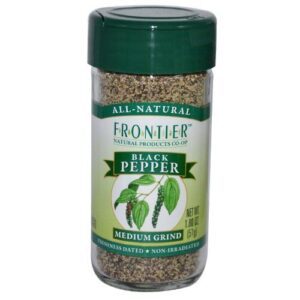
Black pepper is the backbone of any vegetable recipe, and Frontier Co-op’s medium grind delivers that woody, floral kick your summer vegetables deserve. This ethical sourcing champion brings Fair Trade certified flavor to home garden bounty.
The grind size hits the sweet spot for both cooking and finishing dishes. Its pepper flavor profile enhances seasonal cooking without overpowering fresh produce. Sprinkle it on grilled zucchini or stir it into gazpacho.
Beyond taste, health benefits include digestive support. It’s your healthy eating secret weapon for culinary uses across all vegetable recipes.
Frequently Asked Questions (FAQs)
What are some summer vegetable recipes?
When life gives you summer vegetables, toss ‘em on the grill or into a salad—think Grilled Vegetables, crunchy Summer Salads, Garden Pasta, zippy Veggie Stirfries, stuffed squash or bell pepper, and a bowl of Fresh Gazpacho.
How do I use up vegetables from my garden?
Start with smart Garden Planning and whip up a colorful vegetable medley. For summer vegetables, think quick Meal Prep Ideas, creative Vegetable Storage, Food Preservation, or a simple Garden To Table recipe.
Seasonal eating keeps things garden fresh!
Are there no-cook recipes for vegetables?
You bet—no-cook recipes for vegetables are a summer lifesaver. Fresh salad ideas, wraps, and even chilled soups celebrate seasonal produce.
Think crunchy raw vegetable benefits, quick garden meal prep, and endless vegetarian meal options for plant-based diets.
What is the best way to cook summer vegetables?
The best way to cook summer vegetables? Mix it up! Roasting brings out sweetness, sautéing keeps crunch, grilling adds smoky flavor, and blanching holds bright color.
Pair with fresh herbs for healthy, crave-worthy vegetable recipes all season long.
What vegetables are no-Cook?
You know what they say—“fresh is best.” Popular no-cook vegetables include cucumbers, tomatoes, lettuce, bell peppers, and carrots.
Enjoy them raw in summer salads, healthy snacks, or vegetable medleys for peak flavor and nutritional benefits.
How long does it take to prepare a summer vegetable dish?
Prep time for summer vegetable dishes can be as quick as five minutes for raw salads or up to thirty for roasting, depending on your prep method, vegetable size, and recipe complexity.
Speed cooking tips and ingredient prep make a big difference.
What’s the easiest vegetable to grow in a garden?
If you ever wished a vegetable could appear as quickly as downloading a song in the early 2000s, try growing zucchini.
It’s a fast, high-yield, low-maintenance garden star—ideal for summer vegetable recipes and healthy eating.
What to make with fresh garden vegetables?
With fresh garden vegetables, you can whip up vibrant salad recipes, toss zucchini ribbons with lemon, or try quick summer veggie dishes.
Mix and match for endless garden recipe variations and creative ingredient swaps—all season long.
How to can garden vegetables for beginners?
Start with pressure canning for summer vegetables, following trusted recipe selection and vegetable prep. Pay close attention to canning safety, jar sealing, and equipment.
Home canning is perfect for food preservation, Farmers Market hauls, and food waste management.
What vegetables pair well in a garden?
Looking for a thriving vegetable medley? Companion planting creates garden diversity and boosts soil health.
Pair zucchini, squash, bell pepper, and herbs. This approach improves pest control, encourages lush summer vegetables, and makes your garden work smarter, not harder.
Conclusion
If you made every recipe here, your kitchen might just sprout a Michelin star overnight—or at least some very happy family members. The power of easy garden vegetable recipes isn’t just in what you create, but in the stories you cook up along the way.
Each crisp bite is a high-five to your sun-soaked efforts, proof you can turn a vegetable avalanche into a summer feast. Your harvest, your table, your applause. Now, go make dinner legendary.
- https://www.biggergarden.com/gardening-statistics-2023/
- https://www.tasteofhome.com/collection/quick-recipes-you-can-make-with-ingredients-from-the-garden/
- https://www.cheapism.com/garden-vegetable-recipes-14256/
- https://www.nutrition.va.gov/docs/UpdatedPatientEd/2021GardentoTableCookbook.pdf
- https://www.fda.gov/food/nutrition-food-labeling-and-critical-foods/nutrition-information-raw-vegetables

